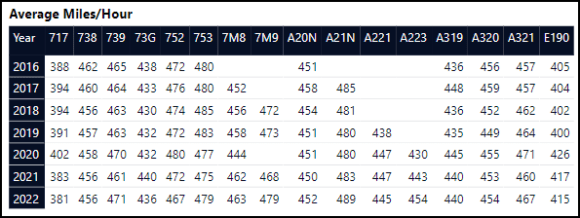
2023 02 13 10 22 45
Airlines sell their product or service according to a schedule. That tells you right away what their focus is – time. Running an airline is tough. The toughest part is that the capital costs are huge, and the labor is skilled – meaning high operating costs per minute. And to complicate things, revenues are fixed while costs are not. What is the value of time for an airline?
Once an airline sells a seat that’s all the revenue they are assured. You might buy WiFi, food, or drinks, but you might not. Airline costs against that ticket revenue, on the other hand, run from the moment that flight planning starts. The costs for that flight end when the airplane pulls in at the gate. Every minute behind schedule costs the airline. Passenger time is valuable but not part of this story. To provide a guide on just how much we are talking about here, the following table lists the operating cost per minute for the larger US airlines.

The bottom row is the industry average. As an industry, these airlines run at ~$110/Minute, and every delayed minute costs serious money. As another guide, consider that in 2022 (through Nov 2022) the industry averaged 21% of flights arriving more than 15 minutes late. The DoT says an arrival within 15 minutes is “on-time”. The reality is any minute after the scheduled arrival is late, and the cost/minute kicks in.
If running an airline is already complicated, then the vagaries of the weather only make it even more like a Larsen comic. It is a really tough gig. You would want to run your fleet in such a way as to save time without burning too much fuel. This is a very challenging balance to accomplish. Can it be done? Does the data show anything?
As it happens, we can parse the data to see how US airlines try to balance time-saving and fuel burn. The following table lists US airlines’ single-aisle fleet performance. The data suggests that the newest models are being flown faster – the system average for single-aisles over the period is 455 MPH.

When we look at what these airlines are doing, we see as new-generation single-aisle models are deployed, they indeed fly faster.

Finally, here is what we have for the current generation of aircraft deployed by US airlines in terms of average speeds.  These aircraft offer better fuel burn (frequently better than OEM promises) so that airlines can meet that precious schedule.
These aircraft offer better fuel burn (frequently better than OEM promises) so that airlines can meet that precious schedule.
Every minute saved means, literally, dollars staying in the bank. As we have shown in other data models, US airline schedules fall apart as the day grows longer. By mid-afternoon, most US airlines are in a schedule deficit and behind. They never catch up on the time lost until the midnight reset.
At least the updating of fleets is going to help lower fuel burn and assist with time savings. Possibly later in the day, we might see the speediest flights of all.
Views: 268





I am not sure where the data comes from. But here is a simple explanation: the newer aircraft are being assigned longer flights, which means more time in cruise (and less time in slower climb and descent). In which case, airlines are NOT deliberately flying at faster speeds!